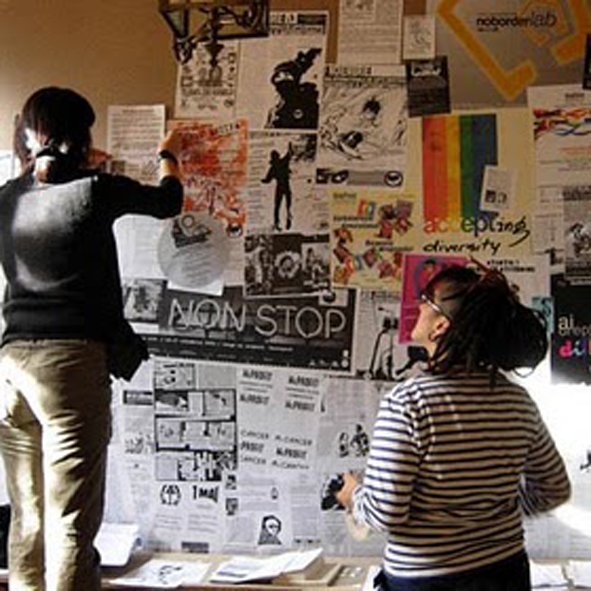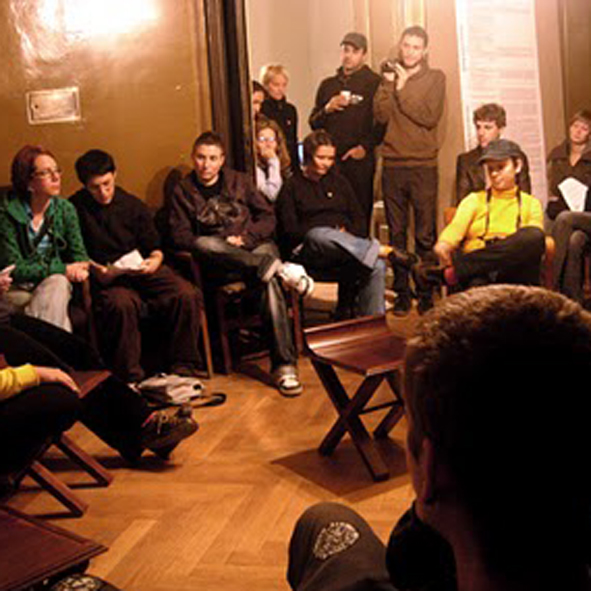Interview with H.arta
H.arta is a collective founded in 2001 in Timisoara composed of Maria Crista, Anca Gyemant, and Rodica Tache.
Olga Stefan: You are a collective of three female artists. How do collaborations evolve among you, and how do you manage to set aside egos in favor of the common goal?
H.arta: Our collaboration is based on our friendship. Friendship, as an inherent part of our lives: fulfils needs of intimacy, trust, and communication; provides an everyday support in the practical contingencies of life; constitutes a continual practice of negotiation in what concerns our ideas, difficulties, disagreements, and inherent hierarchies; ties private life with work and agency, emotion with politics. In this sense, we consider friendship as a useful model of working and living that goes beyond private relations and becomes a political way of interacting with others.
OS: Your practice is a hybrid of cultural or social activism and art. You seem more concerned about the role art has in society and how it can be utilized to change the status quo than about the old “art for art’s sake” routine. Have you found any concrete answers to the question, “What is the use of art in a country so full of social inequalities?”
OS: Your practice is very concerned with actually engaging the publics that you discuss in your projects. What has been their response to your work and how have they reacted to these projects? Do they recognize your projects as art or are they more interested in the social dimension? Do you feel that you have been successful in engaging them?
H: Our projects – which often take the form of spaces for the analysis and debate of social issues tackled in a direct form without too many “artistic filters” – have diverse audiences. With these projects, we want to bring together different voices from various fields, approaching issues from different perspectives and experiences. In these projects, we regard art as a methodology for creating space and for, hopefully, finding strategies for change. We want to get to the “raw material” that could be a topic for art. It is not really important to us if our audience considers what we do is art or not. What is truly important is that the audience considers that the topics we tackle are necessary and urgent, and from this point of view we think that our work is well understood most of the time.
OS: How do you sustain your practice? Are there sources of support for the work that you do?
H: Although many parts of our projects are based on our own and our colleagues’ unpaid work, we have also managed to get funding for projects over the years. The process of getting funding, writing applications, the double talk that it involves and the rhetoric of success that the relationship to the funders suppose (rhetoric that makes it difficult to have a realistic analysis of your work), and the self-censorship, are aspects that are intrinsic to critical art production, aspects that we try to analyze and reflect in our practice. Is it possible to be critical and alternative when visibility for your work is necessary in order to provoke change and can be attained only if you have the resources? How can we avoid the fact that critical cultural projects are sometimes only vents for sustaining the status quo, and sometimes “proof” that the system is democratic enough to sustain “pluralistic” views, views that are condemned to remain sterile in their beautiful, intellectual clarity? We don’t have definite answers to these questions, but we think that one of the most relevant things that can be done in a field that is often governed by appearances and hypocrisy is to make yourself aware of the gap between your words and your actual everyday life and decisions. Our main interest and struggle is to go beyond the mere theoretical field of our ideas and words and try to enact them in our daily lives, even if this struggle involves failure.
OS: To me, the most strident social issues in Romania are the gravely uneven distribution of wealth that leads people to consider capitalism as a great equalizer, and the high level of religiosity present in the public and private spheres, which has led to nationalism and racism. What do you feel are the most pressing problems in Romania and how are you tackling them?


H: In Romania, one of the post-1989 myths about what freedom and a good life mean consisted in the idea that the capitalist system creates and guarantees democracy, that capitalism is a “natural” system whose efficiency is proved by the experience of the powerful countries of the “West.” This idealization of the capitalist system and all the propaganda that goes with it has as a palpable effect: the loss of everything that was gained in the communist times as rights that a large category of people had access to, rights such as access to free education, decent housing, free medical care, and guaranteed pensions. Of course, the uncertainty and unfairness that have become the norm in the conditions opened by the financial crisis are not new to certain categories of people, for those that were always precarious and marginal. Even in communist times, when officially we were all equal, people did suffer for the color of their skin, for example, even if this suffering was not always visible. But what is new is the fact that the suffering of those who are not wealthy enough, not educated enough, not “white” enough, not healthy enough, not competitive enough, not ruthless enough is now made official. Inequality is not seen anymore as an effect of a corrupt and unfair system, but it is declared a natural state, “survival of the fittest” being the rule that we should accept as a basis for the organization of our society. And religion, as an efficient instrument of manipulation, social division, and the creation and sustaining of hierarchies, serves the oppressive system very well, as it always has in the course of history. For us, the way of addressing these problems is the constant attempt to make them visible in our projects and to make the awareness about these problems part of a process of everyday learning and living.
OS: One of your past projects, Project Space (2007), created within the context of Public Art Bucharest, was a physical space where discussions, meetings, and workshops were held to address the main social and political issues at that time. Who was your public then, and do you feel that these types of initiatives can really make a visible impact on the perceptions of the public?

H: In the first h.arta space that we conceived in Timisoara, our public consisted mostly of students and young artists. Project Space, a project space we had in 2008-2009 that functioned in the frame of Public Art Bucharest and also Feminisms, had a diverse public, consisting of persons with different backgrounds. Those who gave it its contents, those who contributed presentations and workshops to its program, constituted part of the public of Project Space. Because Project Space was a meeting platform for various fields, a debate space no longer exclusive to the art sphere where art was used as a set of methods to work with more complex content, our public was more diverse and the border between who is the public and who is the producer of content was blurred. It is difficult to know what was the impact of such a project, to measure its success. But we are glad that new projects and new collaborations emerged, and that some of those who initiated these new projects mention Project Space as an important moment for them.




